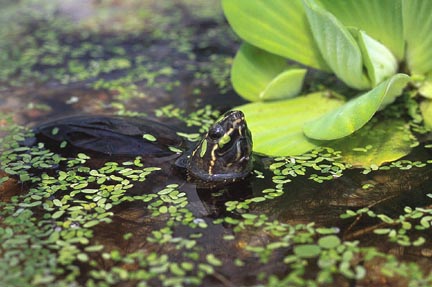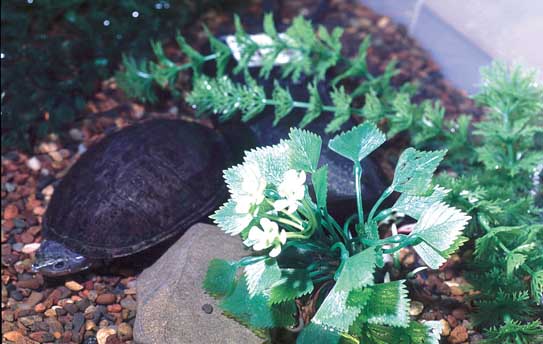
![]() Sternotherus oderatus: The Common Musk Turtle
By Nadine K. Gill
Sternotherus oderatus: The Common Musk Turtle
By Nadine K. Gill
Sternotherus oderatus, also known as the common musk turtle or "stinkpot" is a fascinating little turtle. Beyond it's unassuming carapace lies a interesting natural history, some behavioral traits that are anything but common, and a personality that both feisty - and completely engaging.
Stinkpots are small turtles, with two distinguishing beige or yellow stripes that run from the top and bottom nares of their slightly pointed snout and across the side of their face. It has a domed carapace, a slightly hinged plastron, and under its chin and throat are small beard-like barbels, They are chiefly nocturnal, as evidenced by their large dark eyes, and in the evenings and early mornings you may see them trotting along in the shallows on a river bottom, foraging for food, and using their long neck both to reach their prey and to crane their head up to the surface for a breath of air. They are also accomplished swimmers capable of inhabiting deeper water and when so motivated, will sail through the water with neck extended, looking much like a Canadian goose in flight!
The natural range of S. oderatus is rather large, extending from Quebec and southern Ontario in Canada and from Maine to Florida and west to Texas and Wisconsin in the US. Unlike some of the other musk turtles, S. oderatus are reported to not have a tolerance for brackish water. They tend to prefer slow moving or still water, and though they are a highly aquatic species, rarely coming out to bask in captivity, in their natural habitat they will seeming defy gravity by climbing up near 90 degree angled branches. With surprising strength and a fierce grip, they will hold their hefty little bodies well above the water. When disturbed, adults will quickly drop down, but juveniles may continue to cling fast.
S. oderatus is omnivorous, with juveniles being more carnivorous, and will feed on aquatic snails, carrion, fish eggs, worms, leeches, aquatic insects, larva, algae and aquatic vegetation. They have a sharp beak and strong jaws and care should be taken when handling them. Not all stinkpots will bite, but if annoyed or threatened, they are capable extending their long neck and, in a flash, can whip it back across their carapace and clamp down on an unsuspecting finger. This behavior may be more evident with wild turtles, or newly acquired turtles that are, sadly, almost exclusively collected from the wild. Like other aquatic turtles, S. oderadus may naturally harbor a range of parasites, which with the general stress of collection and mishandling in the pet trade may quickly reach dangerous levels, threatening the health and survival of the turtle. Both to discourage the wild caught trade of these turtles, and to avoid the costly vet bills that may likely follow their purchase from a pet store - finding a captive bred turtle is highly recommended. The other option is adopting a turtle that is in need of a home.
In captivity we want to provide these turtles with an environment that will most closely resemble the conditions of their wild habitat and keep stress to a minimum. Because of their small size, a shallow plastic storage container can meet their needs nicely. They can also be set up quite attractively in an aquarium. Individual personalities differ. Some stinkpots are quite curious and responsive, others are very shy and secretive, but in either case, giving them plant cover in the tank will reduce stress and make them feel more secure. I use small smooth stones as a substrate in my set-up, and soft fern-like plastic plants that trail over sections of the water, which is kept at a depth that allows them to easily reach their head up to the surface while standing on the bottom. As a chiefly nocturnal species, a basking spot is not required. These turtles have also been kept successfully in ambient light without UV-B, but if additional UV-B lighting is desired, a means for retreat should be provided. Such lighting will be necessary if live aquatic plants are included. A piece of cork bark wedged well above the water-line across one side of the tank could provide such retreat, and would also enable the turtle easy access to the surface beneath it for breathing. The inclusion of a riverbank could be added by grading the substrate in a portion of the tank. In the wild, S. oderatus may emerge from the water, often just partially. Such an area with a portion of suitable substrate could also provide a nesting site for gravid females.
A healthy stinkpot will eat heartily, and after a settling in period, should accept suitable prey items (that can be dusted with a calcium and multi-vitamin/mineral supplement), and prepared food, such as Reptomin. Provide a variety of food items, including vegetation. They will likely nibble at aquatic plants such as duckweed, water lettuce and water hyacinth, if offered. This species can host a range of external and internal parasites, and newly acquired turtles should be checked, quarantined and carefully monitored. If symptoms such as anorexia, weight loss, or passing of undigested food are observed, proper diagnosis and treatment should be sought. Another point worth mentioning - the symptoms of respiratory illness may not include open-mouthed gaping in S. oderatus, and congestion may not be evident in some cases. However, if the turtle is holding it's head well above the water for extended periods, respiratory illness should be suspected. This may be accompanied by repeated up and down movements of the head when held above the water, or jerking of the head when under water. Because of their sensitive skin, care should always be taken when handling becomes necessary. Minor cuts and abrasions are susceptible to infection, and should be treated appropriately when they occur. S. oderatus is a hearty little turtle that can live up to sixty years. Providing an appropriate habitat and proper care will help insure that it remains healthy and happy for many years to come.

 In a shallow 24 x 18 inch tank, which I use for one turtle, heat is provided from one submersible aquarium heater (enclosed in protective housing) and a 24 watt Repti-Therm heat pad under about 1/3 of the tank. This allows the turtle to thermoregulate as needed. Keeping in mind their preference for slow-moving water, I installed a Fluval 1 underwater canister filter, directed such that it gently circulates the warmed water by the heater to other areas of the tank. The inclusion of a small airstone can also be beneficial. The species is found from temperate to sub-tropical climates, and depending on the climate and conditions of the habitat, may have year-round activity, or periods of hibernation and/or estivation. Though it is best to provide the turtle with a captive habitat similar to it's own, they can be kept at an acceptable active temperature range from 21-24 C (75-78 F) and provided with a gradient. By providing options in the habitat, and carefully watching the turtle's behavior and preferences, you will learn more about its environmental needs, and be able to make appropriate modifications.
In a shallow 24 x 18 inch tank, which I use for one turtle, heat is provided from one submersible aquarium heater (enclosed in protective housing) and a 24 watt Repti-Therm heat pad under about 1/3 of the tank. This allows the turtle to thermoregulate as needed. Keeping in mind their preference for slow-moving water, I installed a Fluval 1 underwater canister filter, directed such that it gently circulates the warmed water by the heater to other areas of the tank. The inclusion of a small airstone can also be beneficial. The species is found from temperate to sub-tropical climates, and depending on the climate and conditions of the habitat, may have year-round activity, or periods of hibernation and/or estivation. Though it is best to provide the turtle with a captive habitat similar to it's own, they can be kept at an acceptable active temperature range from 21-24 C (75-78 F) and provided with a gradient. By providing options in the habitat, and carefully watching the turtle's behavior and preferences, you will learn more about its environmental needs, and be able to make appropriate modifications.